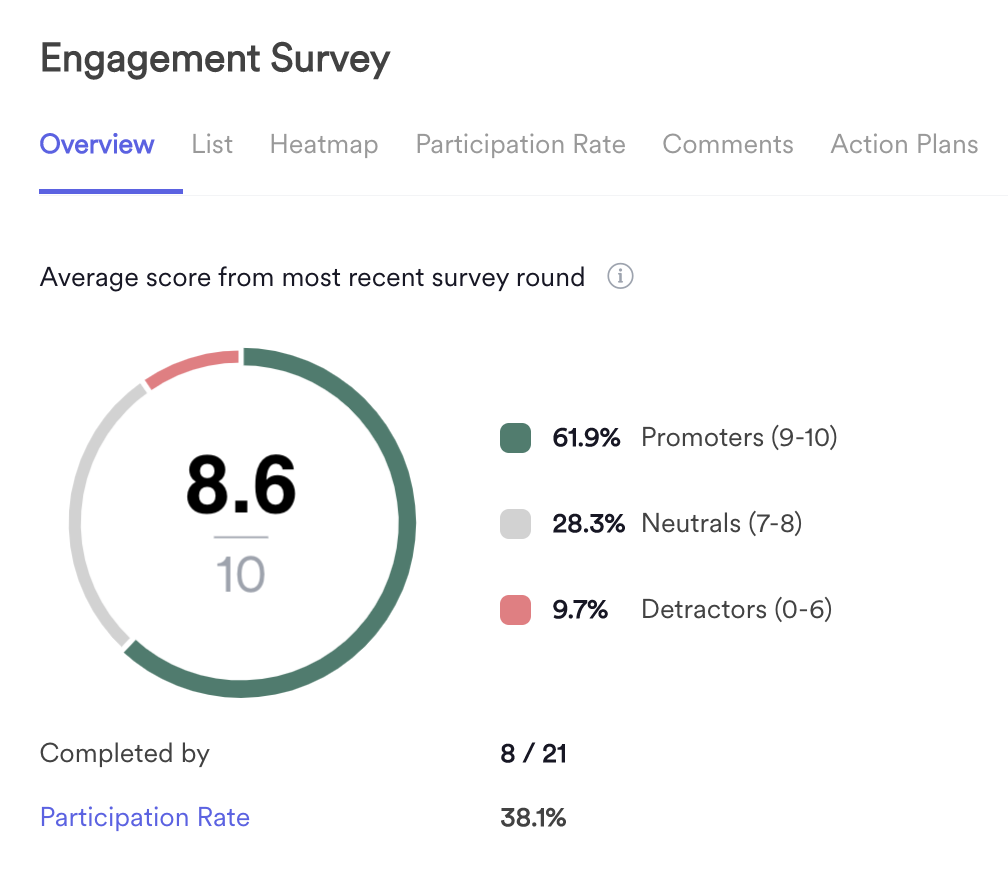1. Enter your eNPS question
To get started with measuring your eNPS, the first step is to use your survey software to create your first eNPS survey.
eNPS surveys are a type of pulse survey — short surveys designed to “take the pulse” of your company. As mentioned before, they usually consist of one rating skale question: “How likely are you to recommend us as a place to work for your family and friends?”
2. Add a follow-up question
You may want to add a quick follow-up question after your eNPS question to gain a deeper understanding of the scores you received.
For best results, try to make this second question short and open-ended. After all, the point of an eNPS survey is to be quick and easy. Use a simple question, like “What was the primary reason for the score you gave?”
By using a follow-up question, you can get a better understanding of your eNPS survey results. This question can help clarify what individual employees mean by their scores, since people may rate you differently depending on their personal understanding of the rating system.
For example, you might have two happy employees. One rates you a 10 and the other gives an 8 or a 9, with the thought that there’s always room for improvement. And of course, if many employees are giving your company low scores, you should want to know why, so you can figure out the source of the problem and fix it.
If you choose to use a follow-up question, be sure to avoid overly specific or leading questions. For example, don’t ask something like “Do you feel unhappy with our new wellness program?”, since this assumes the scores your employees gave have to do with the wellness program rather than something else. Specific questions are better suited to a longer employee survey.
3. Send out your eNPS survey
eNPS surveys should be sent out at least once per quarter. The more frequently you send out surveys, the more closely you’ll be able to track changes in employee engagement.
If your company is growing fast or if you’re in a fast-moving industry, this is even more important — major changes often come with fluctuations in employee engagement.
4. Review your data
Once you’ve sent out your surveys and received responses, it’s time to analyze your data. Have a look at the eNPS scores you’ve received and organize them into the three categories: detractors, passives, and promoters.
5. Calculate your eNPS
Now that you’ve figured out the number of detractors, passives, and promoters you have at your company, it’s time to calculate your eNPS score to understand how your company is doing with employee engagement.
Here’s the formula again:
eNPS = % of promoters minus % of detractors
Let’s say your company has 50 employees. 12 are promoters, 20 are passives, and 18 are detractors. Here, 24% of your employees are promoters, and 36% are detractors. By subtracting the percentage of detractors from the percentage of promoters, you get an eNPS score of -12.
So what exactly does this score mean? A higher eNPS represents a better result, while a lower score represents a worse result. In the example above, the company with an eNPS score of -12 had a slightly higher percentage of detractors than promoters, meaning they still have some work to do on employee engagement. eNPS scores vary from -100 to 100, with 0 being a “neutral” score.
Follow-up best practices for measuring eNPS
Use longer employee engagement surveys alongside eNPS
While eNPS is a great metric to use for a quick snapshot, don’t forget that it’s just a starting point. To get a full picture of how you’re doing with employee engagement, you’ll need to run more in-depth surveys alongside the eNPS.
Sometimes, an employee feels satisfied but not necessarily engaged in their work. They may give you a higher eNPS score but aren’t a high performer. To understand these nuances, it’s important to dig a little deeper with a longer employee engagement survey.
Send out eNPS surveys regularly
Sending out at least one pulse survey per quarter to recalculate your eNPS and keep results up-to-date has the added benefit of getting your employees into the habit of filling out questionnaires. The quarterly rhythm also corresponds with regular business cycles, making it easy to evaluate how any changes in your eNPS relate to quarterly patterns.
Share survey results with employees
Make sure your employees know their concerns are being heard and acted on. Regularly share survey results with them and always provide an action plan for how you’ll address issues.
⭐️ Don’t know where to start with your surveys? 🧘 Take a deep breath. We’re here for you! Start by reading our step-by-step guide to running an employee engagement survey.
And did you know there’s even more you can achieve with employee surveys? Check out our playbooks on running diversity surveys, onboarding surveys, and exit surveys. 😉
Measure eNPS with Leapsome
Leapsome is the only platform that closes the loop between performance management, employee engagement, and learning. With all your people data in one place, the software is giving you unmatched people analytics and insights.
Easily measure the pulse of your company culture with engagement surveys, track changes in customizable dashboards, and get actionable, data-driven recommendations for increasing your employee engagement.



%202%20(1).png)

.webp)
.webp)







